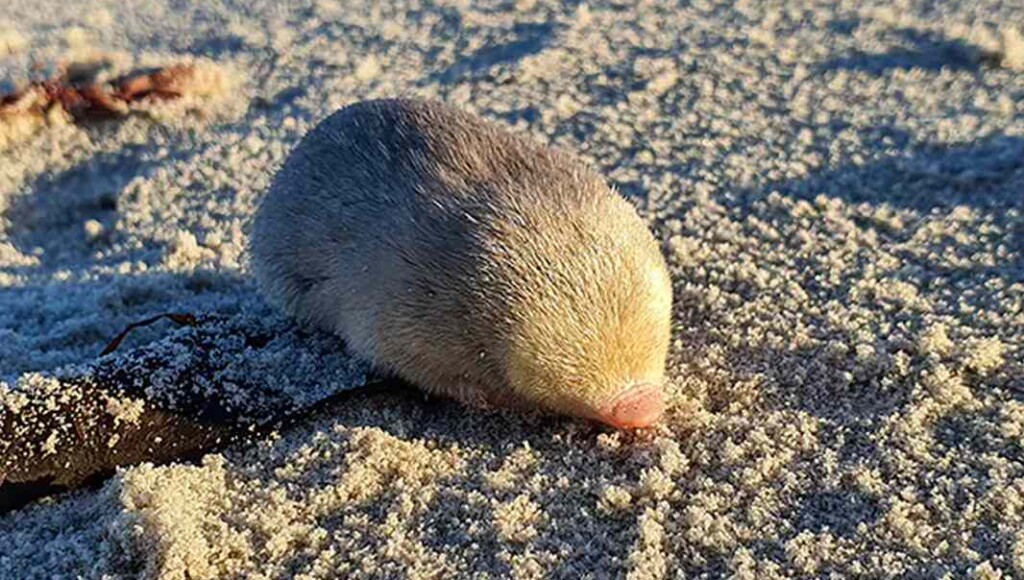
A little species of golden mole has been rediscovered in South Africa thanks to an intrepid band of conservationists and a sniffing dog.
De Winton’s golden mole was last scientifically documented in South Africa–in Port Nolloth–in 1936. This tiny, blind mammal was never photographed and there is little known about its behaviour.
Furthermore, without any physical specimen to examine, it was impossible to train a sniffing dog to find these little creatures that burrow under the sand and navigate by detecting vibrations through the tissue in their large noses.
Thinking that maybe De Winton’s mole smells the same as another of the 21 golden mole species, the team led by program manager Cobus Theron from South Africa’s Endangered Wildlife Trust (EWT) trained a border collie named Jessie to lay down on the ground when she smelled one of these other moles.
Sand dunes posed another challenge to the golden mole of De Winton: they were a new environment. After a certain number of hours, sand dunes will have moved by some number of meters as winds blow the sand in different directions. Because the moles only burrow 4 inches under the ground, their tracks and dens are easily scrubbed away.
The challenge for the third time was to identify De Winton’s Golden Mole in the absence of a sample from history, a description that explains how it differs from all other golden moles and DNA.
Fortune was on the side of Theron and his team, for when they arrived at Port Nolloth for a 2022 expedition, a rainstorm had frozen the tracks of the area’s moles in time in the wet sand. Ironically, Jessie the collie was completely uninterested in the scene, meaning that the tracks were made by a mole whose scent she didn’t recognize.
MORE LOST SPECIES FOUND: Lost for 97 Years, Rediscovered Magnolia Tree Spurs Hope for its Restoration in Haiti
“The team collected more than 100 samples from the sand to take back to the lab for eDNA–short for environmental DNA–analysis,” writes Re:wild, one of the organizations that supported the effort.
“eDNA is the DNA that animals, such as hair, skin, or scat, leave behind when they travel through an environment. .”
Re:wild supports the rediscovery of lost species through their innovative and wildly successful “25 Most Wanted” list, which highlights important species that are lost to science, organizes expeditions to find them, and funds conservation based on the publicity of the rediscoveries. So far, De Winton’s golden mole is the 12th the org has crossed off its list.
With the eDNA sequences, the team was able to compare mitochondrial DNA to a specimen of mole held at the Port Nolloth Museum: it was a match.
“It’s been so exciting for me to make this discovery alongside a group of people with a shared interest and vision for golden moles to raise awareness about their presence, about their plight,” says Samantha Mynhardt, a conservation genetics researcher at the Endangered Wildlife Trust.
The only reason journalists and scientists can pronounce a “6th mass extinction” is because many small and seemingly unimportant species like De Winton’s golden mole are going extinct every year. Altogether, they paint a picture of a global biodiversity crisis.
MORE NEWS LIKE THIS: Earless Dragon Feared Extinct is Rediscovered After 50 Years in Australia
This tiny mammal is a great example of how a healthy ecosystem can be created by the existence of many small, unknown species.
“I think it’s just fantastic that in 2023 we can still rediscover species,” said team leader Theron. “All of our stories around conservation are doom and gloom. Here we have an opportunity to say that, actually, there are opportunities to make change.”
SHARE This Sniffing Dog, Tiny Mole, And Hope For The Future With Your Friends…




Leave a Reply